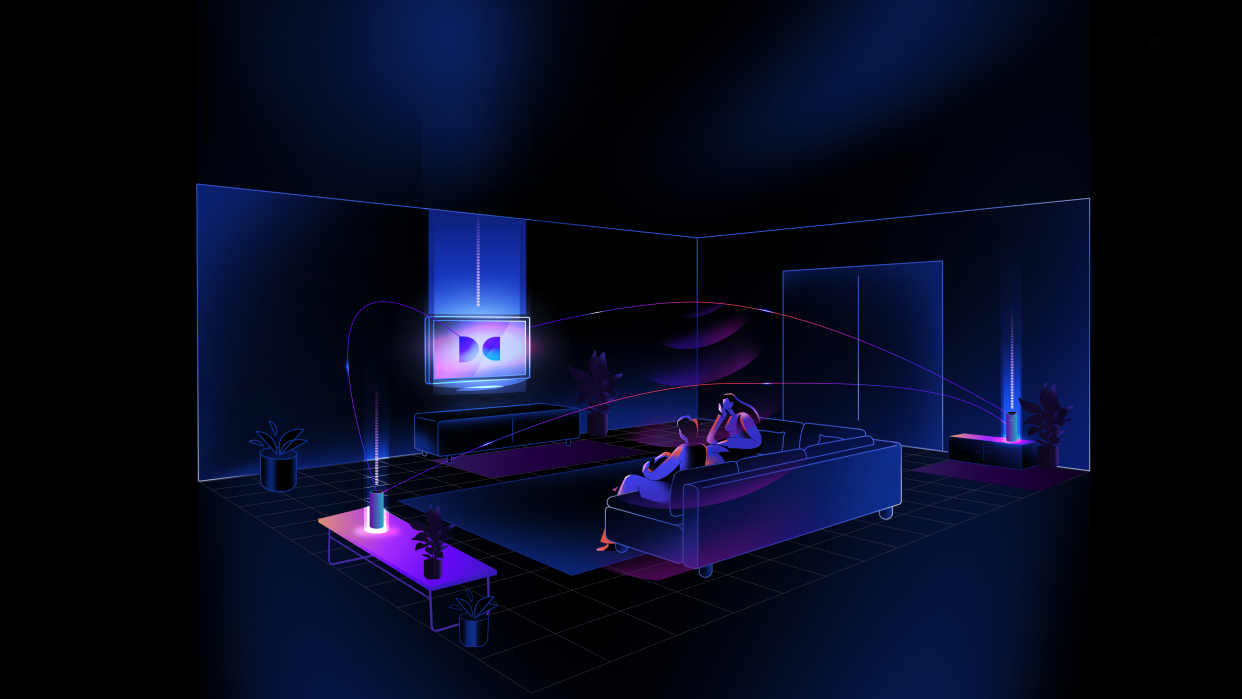What is Dolby Atmos FlexConnect? All the details on the new wireless 3D surround sound tech

Atmos is getting an upgrade. At IFA 2023, Dolby announced a new variation on its 3D Audio tech that will apparently be much less fussy about speaker placement. In theory, it means you can put your speakers wherever you have room, rather than being forced to redesign the whole living space around your TV and home entertainment setup.
So how does it work? When will it launch? And will it work as advertised? Find out here...
What is Dolby Atmos FlexConnect?

Dolby Atmos FlexConnect is the next generation of Dolby Atmos. It aims to deliver the same experience of Dolby Atmos (i.e. 3D sound through the addition of height channels), but without specifying where you need to place your speakers.
Hold on there. Let's back up a bit.
Dolby Atmos adds to traditional 5.1 or 7.1 speaker systems by adding height channels – that means sounds can not only be placed in front, behind or to the side of you, but above as well. For most home viewers, that means buying a Dolby Atmos-compatible AVR with Atmos Height Virtualization – this creates the height effect using speakers at the listener level, negating the need to drill holes in your ceiling and mount speakers up there. These can be quite affordable too (though these things are always relative), for example, the excellent Denon AVR-X2800H, the Denon AVC-X3800H and the Sony TA-AN1000.
Or you can buy an Atmos speaker package that incorporates upward-firing drivers to reflect sound off the ceiling and towards your listening position to create an overhead effect. These often come in the form of 'speaker toppers' that sit upon your front and/or surround speakers, and can either be bought separately or as part of a full package.
In a perfect world, you'd partner your listening-level speaker package with two or four speakers mounted into your ceiling, creating a 'reference' standard Dolby Atmos system.
Sound like too much effort? You can also get Atmos in a soundbar (here's our list of the best Dolby Atmos soundbars). You might doubt that you can get a convincing height-and-surround effect from a single source, but while it is fair to say that you're not going to get a reference-level performance in this way, soundbars such as the Sonos Arc (pictured) are surprisingly effective.
With Atmos so widespread, it's only natural that Dolby wants to expand it even further. Because FlexConnect lets you place your speakers wherever you want, it allows for much more versatile setups. Which could bring Atmos to more people than ever before.
How does Dolby Atmos FlexConnect work?

Dolby demoed FlexConnect at the IFA trade show in August. To begin with, FlexConnect-compatible speakers fire out a series of test tones to let the TV know where they're positioned and provide information on the room's overall acoustics. This calibration process takes a few seconds, and you only have to repeat it if you move your speakers or TV.
The TV then shows on screen where the speakers are positioned so you can check it's the calibration step has worked correctly.
Then, when you watch something, the TV and speakers work in cahoots with each other to adjust the audio to compensate for the speakers' placement. Position them behind the sofa, wedged between the TV cabinet and window ledge, on top of the bookcase... the audio should always sound the same regardless of where they're put. That's the theory, anyway.
This is all done wirelessly. Currently, there are systems that involve Atmos being transmitted wirelessly to speakers, but these all require something to be wired directly to the TV – for Sonos, the Beam (Gen 2) or Arc can send Atmos signals to Era 300 speakers but the soundbar has to be wired to the TV first, Sony's HT-A9 speaker system has wireless Atmos speakers but there's also a transmitter box that's connected to a TV, and WiSA technology can now handle Atmos, too, for example with the recently announced Platin Milan 5.1.4 system, but again that requires a small transmitter to be connected via cable to the TV.
There is one potential downside: instead of a soundbar, FlexConnect uses the TV as the centre channel. As you'll know if you've read any of our TV reviews, TV sound is invariably awful. Even the best TVs around pale in comparison to a soundbar. In fact, some of Sony's top TVs can take on the centre-channel duties in a surround system, but they struggle to tonally match the audio of the rest of the speakers in the system, despite these TVs being some of the best-sounding on the market today.
The centre channel is the most important in any surround sound setup, as it's the one that handles almost all dialogue and effects, so this being potentially the worst speaker in the system could be a problem for FlexConnect.
We say "could" because we haven't experienced it outside of a noisy demo area at a trade show. We'll know for sure once we start reviewing Atmos FlexConnect-compatible products.
What devices will work with Dolby Atmos FlexConnect?
No Dolby Atmos FLexConnect devices have been announced yet, but the tech will launch on TCL TVs. Expect to see it come to more devices from more brands after that, but at the moment, Dolby hasn't announced any more partners.
When will Dolby Atmos FlexConnect launch?
These TCL TVs with Atmos FlexConect will launch in 2024. We're expecting to hear a lot more about FlexConnect at CES in January – we'll update this article as soon as we have any more information.
MORE:
Dolby Atmos Music: everything you need to know
